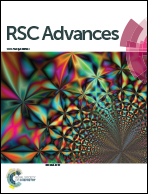Conductive casting films based on an octasilicate-core dendrimer containing the mixed-valence state TCNQ on the periphery†
Abstract
An octasilicate (OS)-core dendrimer terminated with imidazolium–7,7,8,8-tetracyanoquiodimethane (TCNQ) anion radicals (OS-mimTCNQ) was synthesized from an OS-core dendrimer having alkyl bromides as terminal groups (OS-mimBr) via anion exchange reaction with lithium TCNQ salt (LiTCNQ) in water. Conductive films were prepared by casting mixtures of OS-mimTCNQ with the neutral TCNQ in acetonitrile on glass substrates. Although the casting film of OS-mimTCNQ showed low conductivity (<10−6 S cm−1), the casting films showed relatively high electron conductivity. In particular, the casting film with the same feed molar ratio between the neutral TCNQ and the terminated imidazolium moiety (OS-CT1.0) showed the highest conductivity (5.4 × 10−2 S cm−1). The stacking structure with the mixed-valence state of TCNQ in these casting films was confirmed by UV-vis-NIR spectra. The grazing incidence X-ray diffraction (GI-XD) of OS-CT1.0 showed an anisotropic pattern, indicating that the OS-core dendrimer arranged in the direction of the out-of-plane.


 Please wait while we load your content...
Please wait while we load your content...